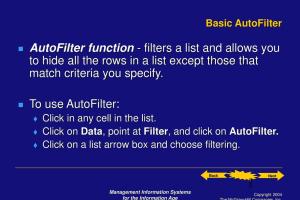Mastering Easy AutoFilter: A Beginner’s Guide to Effortless Data Management

-
Quick Links:
- 1. Introduction to AutoFilter
- 2. What is AutoFilter?
- 3. Why Use AutoFilter?
- 4. Setting Up AutoFilter
- 5. Using AutoFilter: Step-by-Step
- 6. Customizing AutoFilter Options
- 7. Case Studies: Real-World Applications
- 8. Common Issues and Troubleshooting
- 9. Best Practices for Using AutoFilter
- 10. Conclusion
- 11. FAQs
1. Introduction to AutoFilter
Are you tired of manually sifting through endless rows of data? Whether you're a student, a professional, or just someone looking to organize personal information, mastering the AutoFilter feature in spreadsheet applications like Microsoft Excel can significantly enhance your productivity. This guide provides an in-depth look at AutoFilter basics, helping you navigate your data effortlessly.
2. What is AutoFilter?
AutoFilter is a built-in feature in spreadsheet software that allows users to quickly filter data based on specific criteria. By applying filters, you can display only the relevant information you need, making data analysis much more manageable.
3. Why Use AutoFilter?
- Efficiency: Streamlines data management by reducing clutter.
- Data Analysis: Facilitates easier data interpretation and decision-making.
- Customization: Offers various filtering options tailored to your needs.
- Time-Saving: Reduces the time spent searching through data.
4. Setting Up AutoFilter
To set up AutoFilter in Excel, follow these simple steps:
- Open your Excel spreadsheet containing the data you want to filter.
- Select the range of cells that you want to filter.
- Go to the Data tab on the Ribbon.
- Click on the Filter button.
Once you click the Filter button, dropdown arrows will appear in the header of each column, indicating that you can now use AutoFilter.
5. Using AutoFilter: Step-by-Step
Now that you have set up AutoFilter, let’s dive into how to use it:
- Click the dropdown arrow in the header of the column you want to filter.
- From the dropdown menu, you can choose to filter by specific values or conditions (e.g., greater than, less than, etc.).
- Check or uncheck the boxes next to the values to display the data you want.
- Click OK to apply the filter.
Your data will now only show rows that meet the criteria you selected!
6. Customizing AutoFilter Options
AutoFilter offers several customization options to enhance your data filtering experience:
- Text Filters: Filter data based on specific text criteria.
- Number Filters: Filter data based on numerical conditions.
- Date Filters: Filter records based on date ranges.
- Color Filters: Filter based on cell or font colors.
7. Case Studies: Real-World Applications
Understanding how AutoFilter is used in real-world scenarios can solidify your grasp of its practical applications. Here are a few case studies:
Case Study 1: Sales Data Management
A retail company utilizes AutoFilter to manage sales data. By filtering sales records by specific regions, they can analyze performance trends and make informed decisions on marketing strategies.
Case Study 2: Academic Research
Researchers use AutoFilter to sift through vast amounts of data collected during their studies. By filtering participants by age or gender, they can focus on specific demographics for their analyses.
8. Common Issues and Troubleshooting
Despite its convenience, users may encounter some common issues when using AutoFilter:
- Missing Filter Options: Ensure that your data has column headers.
- Filters Not Working: Check if your data range includes blank rows.
- Unexpected Results: Verify your criteria settings to ensure accuracy.
9. Best Practices for Using AutoFilter
To maximize the benefits of AutoFilter, consider implementing these best practices:
- Always ensure your data table has headers.
- Regularly update your filters to ensure data accuracy.
- Familiarize yourself with the different filtering options available.
10. Conclusion
Mastering the AutoFilter feature in Excel can save you time and effort in managing data. By following the steps outlined in this guide, you'll be well-equipped to filter data effectively and make informed decisions based on your analyses.
11. FAQs
What is AutoFilter in Excel?
AutoFilter is a feature that allows users to filter data in a spreadsheet based on specific criteria.
How do you enable AutoFilter?
You can enable AutoFilter by selecting your data range and clicking the Filter button in the Data tab.
Can AutoFilter be used on large datasets?
Yes, AutoFilter can efficiently manage large datasets, though performance may vary based on your system specifications.
What if my filter options are missing?
Ensure your data has headers and that there are no blank rows in your dataset.
Can I filter by multiple criteria?
Yes, you can apply multiple filters across different columns to narrow down your search.
Is AutoFilter available in Google Sheets?
Yes, AutoFilter functionalities are also available in Google Sheets, although the interface may differ slightly.
How do I remove a filter?
Click the Filter button again in the Data tab to remove filters, or choose "Clear Filter" from the dropdown menu.
Can I sort data while using AutoFilter?
Yes, you can sort data in the filtered view by clicking the dropdown arrow and selecting sort options.
What are some common uses for AutoFilter?
Common uses include data analysis, sales tracking, and organizing research data.
Are there any limitations to AutoFilter?
AutoFilter cannot handle complex queries and is limited to filtering data based on straightforward criteria.
Random Reads
- How to create icloud account ios
- How to create ethernet cable
- Recover google chrome passwords
- Ultimate elite four battle guide
- How to make a smokeless fire pit
- How to make a simple electrical circuit
- How to put a hyperlink in a powerpoint
- How to install a modem
- How to install a network printer
- How to safely kill creepers in minecraft